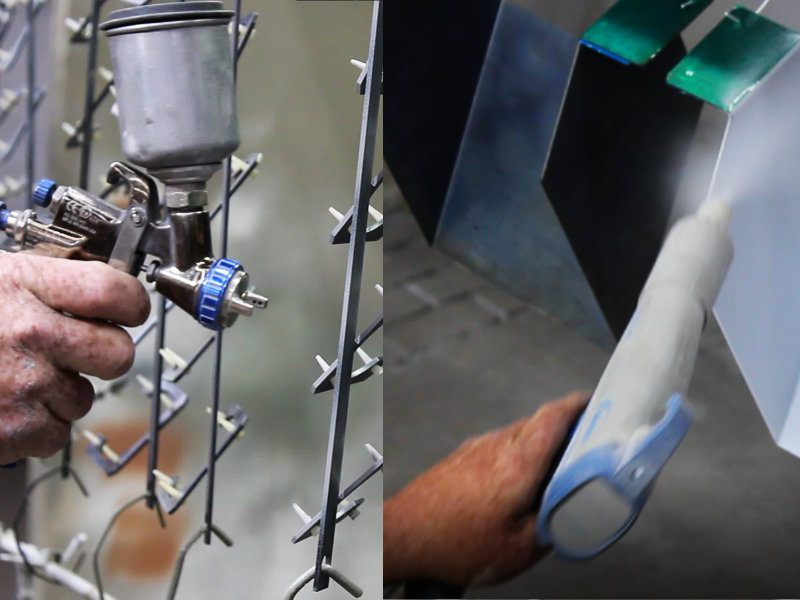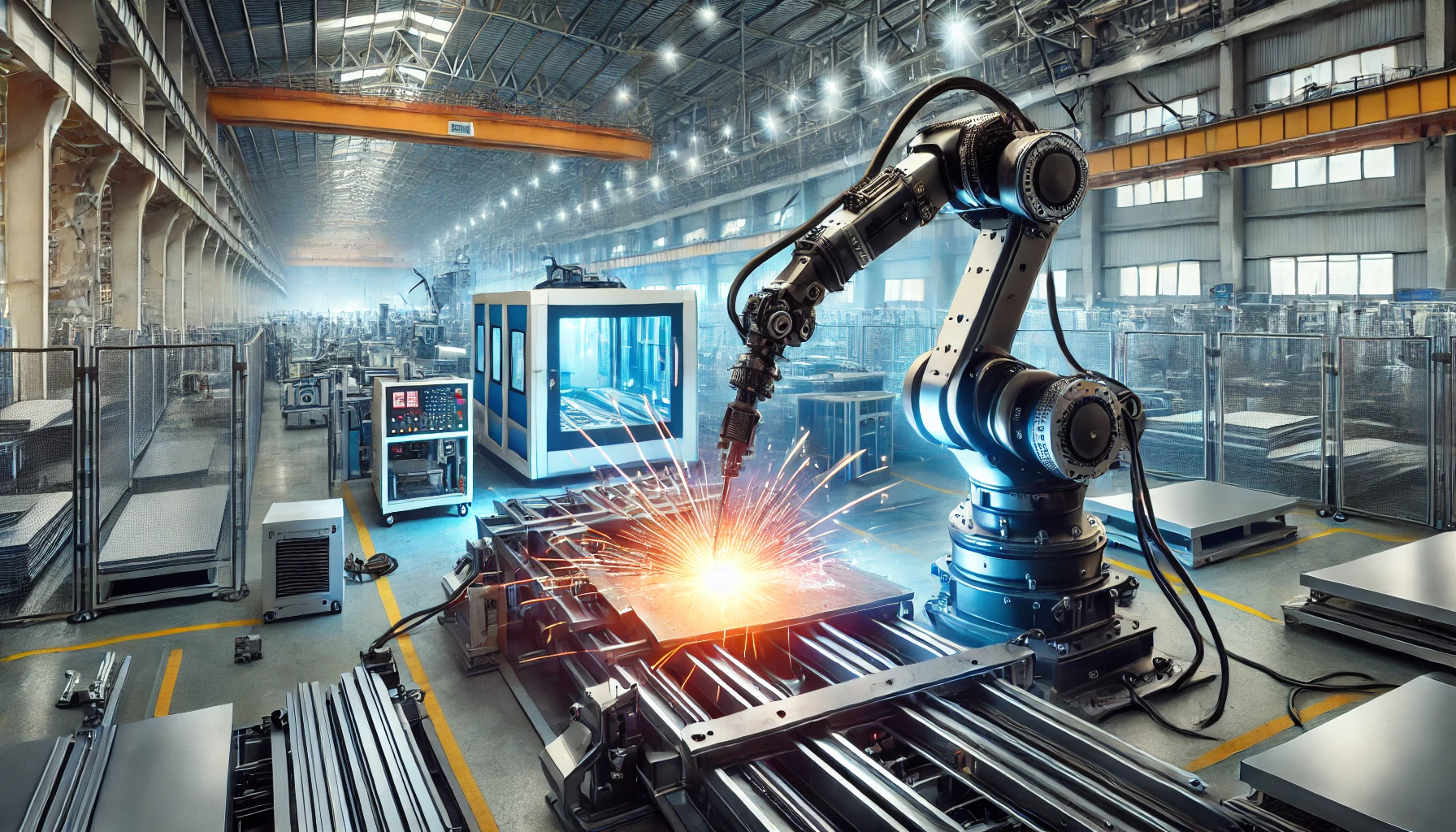What Is Powder Coating?
Powder coating is a type of coating process that is used to apply a protective and decorative finish to a wide range of materials. It involves applying a fine powder made of a combination of resin, pigment, and other additives onto a surface. The powder is electrostatically charged, which causes it to adhere to the surface.
The process of powder coating typically involves the following steps:
- Surface Preparation: The surface to be coated is cleaned and prepared to remove any dirt, grease, or contaminants. This step ensures proper adhesion of the powder to the surface.
- Powder Application: The powder is applied to the surface using a specialized spray gun or an electrostatic spray system. The powder particles are charged with an electrical current as they are sprayed, which causes them to cling to the grounded surface.
- Curing: Once the powder is applied, the coated object is transferred to an oven or a curing chamber. The heat causes the powder to melt and flow, forming a smooth and continuous film. The curing process also helps in cross-linking the resin molecules, resulting in a durable and resilient coating.
- Cooling and Finishing: After the curing process is complete, the coated object is allowed to cool down. Once cooled, the coating hardens and becomes tough. The finished coating is resistant to chipping, scratching, fading, and corrosion.
Benefits of Powder Coating
Powder coating offers several advantages over traditional liquid coatings. It provides a thicker and more uniform coating, has better durability and resistance to chemicals and UV rays, and produces less waste since overspray can be reused. Additionally, powder coating is available in a wide range of colors, finishes, and textures, allowing for various aesthetic options.
Limitations of Powder Coating
While powder coating has many advantages, it also has some limitations. Here are a few notable limitations of powder coating:
- Thin Film Application: Powder coatings are typically applied in thicker layers compared to liquid coatings. This can result in a loss of fine details and sharp edges in intricate or delicate parts.
- Limited Color Range: Although powder coating offers a wide variety of colors, finishes, and textures, it may not be able to match the extensive color range available with liquid coatings. Certain specialized or custom colors may be more challenging to achieve with powder coating.
- Heat Sensitivity: The curing process of powder coating requires heat to melt and fuse the powder. This can be a limitation for heat-sensitive materials, such as certain plastics or heat-sensitive electronic components, as they may get damaged or deformed during the curing process.
- Difficulties with Thin or Small Parts: Powder coating can be challenging for very thin or small parts. The electrostatic charge may not distribute the powder evenly, resulting in uneven coating thickness or difficulty in achieving proper coverage.
- Limited Touch-Up Options: Unlike liquid coatings, which can be easily touched up or repaired, powder coatings have limited touch-up options. Once cured, it is difficult to reapply powder coating to specific areas without recoating the entire object.
- High Initial Investment: Setting up a powder coating operation requires specialized equipment, such as spray booths, curing ovens, and electrostatic spray guns. The initial investment can be relatively high, especially for small businesses or individuals looking to perform occasional coating tasks.
- Limited Flexibility: Powder coatings can be less flexible compared to certain liquid coatings. This lack of flexibility may result in cracking or peeling when applied to materials that undergo frequent bending or flexing, such as certain types of plastics.
Despite these limitations, powder coating remains a popular and widely used coating method due to its durability, environmental friendliness, and overall advantages over traditional liquid coatings. Manufacturers and industries carefully consider these limitations and choose the appropriate coating method based on their specific needs and requirements.
What Is Wet Paint?
“Wet paint” refers to paint that has been freshly applied and has not yet dried or cured. It is in a liquid or semi-liquid state and can be easily manipulated or spread on a surface. Wet paint is typically sticky and may have a glossy or semi-glossy appearance.
Wet paint can be applied using various methods, such as brush painting, roller application, or spray painting. It consists of a liquid paint formulation that contains pigments, binders, solvents, and additives. The pigments provide color, while the binders help the paint adhere to the surface and form a protective film as it dries.
After the wet paint is applied, it undergoes a curing or drying process, during which the solvents in the paint evaporate, allowing the binders to solidify and create a durable coating. The drying time can vary depending on factors such as the type of paint, environmental conditions (temperature, humidity), and the thickness of the applied coat. It is important to allow sufficient drying time for the paint to fully cure and develop its desired properties.
Wet paint is commonly used in various applications, including residential and commercial painting projects, automotive refinishing, furniture finishing, and artistic creations. It offers a wide range of color options, finishes, and textures, providing versatility and aesthetic appeal.
Benefits of Wet Paint
Wet paint, or traditional liquid paint, offers several benefits that make it a popular choice for various applications. Here are some of the advantages of wet paint:
- Easy Application: Wet paint can be easily applied using various methods, such as brushes, rollers, or spray guns. It allows for precise control and manipulation of the paint, making it suitable for both large surfaces and intricate details.
- Wide Color Selection: Liquid paint offers an extensive range of color options, including custom or specialized colors. Manufacturers can create virtually any desired color by mixing different pigments, providing flexibility and customization.
- Seamless Coverage: Wet paint spreads smoothly and evenly over the surface, allowing for a seamless and uniform coating. It can easily cover imperfections, such as scratches or blemishes, resulting in a visually appealing finish.
- Versatile Finishes: Liquid paint can achieve a variety of finishes, including glossy, satin, matte, or textured. This versatility allows for different aesthetic options and the ability to match specific design requirements.
- Touch-Up and Repair: Unlike powder coating, wet paint allows for easy touch-up or repair of damaged or worn areas. It is possible to blend in the new paint seamlessly with the existing coating, making it a convenient option for maintenance and refinishing.
- Flexibility: Wet paint remains flexible even after drying, allowing it to withstand minor movements or expansions and contractions of the substrate. This flexibility makes it suitable for materials that experience bending or flexing, such as certain types of plastics or wood.
- Compatibility with Different Surfaces: Wet paint can adhere to a wide range of surfaces, including metal, wood, plastics, and more. With the appropriate surface preparation and primer, it can create a strong bond and provide long-lasting protection.
- Cost-Effectiveness: Liquid paint is generally more cost-effective than powder coating, especially for smaller projects or irregularly shaped objects. It requires less specialized equipment and initial investment, making it accessible to a broader range of users.
- Easy Color Change: Wet paint allows for easier color change or repainting if desired. The existing paint can be removed or coated over without the need for stripping the entire coating, providing flexibility for design updates or changes.
- Accessibility: Wet paint products are widely available and can be found in various retail stores, making them easily accessible for DIY projects or small-scale applications.
It’s worth noting that wet paint may have longer drying and curing times compared to some other coating methods, and the use of solvents in liquid paint formulations may have environmental considerations. Proper ventilation and safety precautions should be followed when using and handling wet paint products.
Limitations of Wet Paint
While wet paint offers many advantages, it also has some limitations. Here are a few notable limitations of wet paint:
- Longer Drying Time: Wet paint typically requires a longer drying time compared to other coating methods. It can take hours or even days for the paint to fully dry and cure, depending on factors such as humidity, temperature, and the type of paint used. This extended drying time can delay project completion and increase the risk of dust or dirt settling on the wet surface.
- Environmental Considerations: Liquid paints often contain volatile organic compounds (VOCs) and other solvents, which can have environmental and health implications. VOCs contribute to air pollution and can have harmful effects when inhaled. To mitigate these concerns, low VOC or zero VOC paint options are available, but they may be more expensive or have limited color choices.
- Smell and Fumes: Wet paint can emit strong odors and fumes during application and drying. This can be unpleasant and may require proper ventilation or protective equipment to ensure a safe working environment.
- Over-spray and Waste: When applying wet paint with spray guns, there is a risk of over-spray, which can result in wasted paint and increased costs. Proper masking and containment measures are necessary to minimize over-spray and control paint waste.
- Thinner Coating Thickness: Wet paint typically forms thinner coating layers compared to powder coating. This can result in a slightly lower level of durability and resistance to physical impacts, chemicals, and weathering.
- Limited Texture Options: While wet paint offers a variety of finishes, it may have limitations when it comes to creating specific textures or patterns. Achieving textured or specialized effects may require additional techniques or materials.
- Limited Shelf Life: Once opened, liquid paint has a limited shelf life and may start to degrade or thicken over time. This can result in reduced paint quality and application issues if the paint is not used within a certain time frame.
- Difficulty with Thin or Detailed Surfaces: Wet paint may pose challenges when applied to thin or intricate surfaces, such as fine details or sharp edges. The liquid consistency of the paint may cause it to pool or run, leading to uneven coverage or loss of fine details.
- Prone to Runs, Drips, and Sagging: If not applied carefully, wet paint can be prone to runs, drips, or sagging, especially on vertical or inclined surfaces. Proper technique, equipment, and application thickness control are necessary to avoid these issues.
Despite these limitations, wet paint remains a widely used coating method due to its versatility, accessibility, and ability to achieve a wide range of colors and finishes. Manufacturers and individuals carefully consider these limitations and choose the appropriate coating method based on their specific needs and circumstances.
Get Custom Sheet Metal Fabrication Finishing Services
At Blackstone Advanced Technologies, we’re committed to helping you attain the finish for your parts. Powder coating or wet paint, we’ve got you covered, literally. We’re the custom sheet metal fabrication you can count on delivering you exceptional results.
Request a quote and lets get your product finished.



